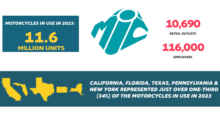May 25, 2009 – Finance Digest
Harley finalizes funding agreements
Harley-Davidson and its subsidiary Harley-Davidson Financial Services (HDFS) finalized agreements to provide about $1 billion in funding capacity to support HDFS lending this year, stated Harley-Davidson in a press release.
HDFS increased the size of an existing $500 million asset-backed commercial paper conduit facility to up to $1.2 billion, based on the level of outstanding receivables, which expires April 29, 2010. Additionally, Harley-Davidson and HDFS have replaced a 364-day, $950 million bank credit facility expiring July 31, with a new
364-day, $625 million credit facility expiring April 29, 2010. Together, the two agreements provide additional available credit of up to about $375 million over the term of the agreements, for the lending activities of HDFS.
In February, the company completed an offering of $600 million in senior unsecured notes. First- and second-quarter 2009 dividend reductions combined are preserving about another $100 million in cash.
Kawasaki reports reduced fiscal-year sales, net income
Kawasaki Heavy Industries’ (KHI) consumer products and machinery division, which includes powersports vehicles, reported a 22 percent decrease in sales for its recent fiscal year.
Sales in the consumer products and machinery division totaled $3.4 billion for the fiscal year.
Overall, KHI’s net sales of $13.6 billion represented a nearly 11 percent drop from the year-ago period. The company’s net income of $119 million dropped more than 66 percent from the year-ago period.
Piaggio: Sales up in North America but down worldwide
The Piaggio Group is reporting decreased worldwide sales in its first quarter but increased business in North America.
The company reported a 20 percent dip in its worldwide vehicle sales and a 15.8 percent downfall in overall sales.
However, the company’s first-quarter vehicle sales in North America increased to 6,400, an improvement of 50.5 percent.
Piaggio Group, however, did finish its first quarter with a net loss of $6.2 million after ending the prior-year period with a net income of $4.2 million.
Another change affects enforcement of Red Flags Rule
The Federal Trade Commission (FTC) will delay enforcement of the new “Red Flags Rule” until Aug. 1 to give creditors and financial institutions more time to develop and implement written identity theft prevention programs, it reported in a recent statement.
Under this rule, powersports dealerships that provide or arrange financing are defined as creditors, as are any businesses that provide services and bill later.
For entities that have a low risk of identity theft, such as businesses that know their customers personally, the commission will soon release a template to help them comply with the law, the FTC reported.
“Given the ongoing debate about whether Congress wrote this provision too broadly, delaying enforcement of the Red Flags Rule will allow industries and associations to share guidance with their members, provide low-risk entities an opportunity to use the template in developing their programs, and give Congress time to consider the issue further,” said FTC Chairman Jon Leibowitz.
The Fair and Accurate Credit Transactions Act of 2003 (FACTA) directed financial regulatory agencies, including the FTC, to promulgate rules requiring “creditors” and “financial institutions” with covered accounts to implement programs to identify, detect and respond to patterns, practices or specific activities that could indicate identity theft, according to the FTC.
During outreach efforts last year, the FTC staff learned that some industries and entities within the agency’s jurisdiction were uncertain about their coverage under the Red Flags Rule. During this time, FTC staff developed and published materials to help explain what types of entities are covered, and how they might develop their identity theft prevention programs. Among these materials were an alert on the Rule’s requirements, www.ftc.gov/bcp/edu/pubs/business/alerts/alt050.shtm, and a Web site with more resources to help covered entities design and implement identity theft prevention programs, www.ftc.gov/redflagsrule. The compliance template will be available on this Web site.
KTM worldwide sales decrease 22 percent in its first half
Austrian manufacturer KTM reported its worldwide sales have dropped more than 20 percent for its first half.
The OEM sold 32,034 vehicles, a drop of 31 percent for its first half compared to the previous-year period. Overall worldwide sales fell 22.6 percent to $295 million, KTM reported.
Despite the decrease in sales, KTM said it is continuing with two key projects: an electric-powered Enduro motorcycle and a small-engine, on-road motorcycle. The latter project is being developed in partnership with Indian manufacturer Bajaj Auto. KTM said it will show off the 125cc street motorcycle destined for the European market in Milan in November.
KTM also said of the Bajaj partnership, “These projects will point the way toward the development of other models and vehicles with new drive concepts for off-road and urban use.”
XpressCredit Expands its Loan Origination System
XpressCredit announced the addition of a customer information verification tool, FacTrack, to its loan origination system.
FacTrack is a flexible tool for lending institutions to verify and cross reference customer information. Integrated employment, paystub and budget tools analyze application data for discrepancies. A score is determined based on the verification results to confirm authentication of stipulations.
Questions, answers and the related scoring system are customized to the lender’s criteria. A comprehensive system for building custom forms allows verifier notes to be added to any field. Upon completion of the process, the FacTrack verification report can be printed,
e-mailed and archived. This tool was designed to be used in conjunction with the XpressCredit platform, but it can be used as a stand-alone, Web-based application.
“The FacTrack tool is a key component in the loan approval process. This additional functionality allows lenders utilizing XpressCredit technology to create their own verification criteria and score applicants based on the information provided,” said Mark Louer, XpressCredit’s executive vice president.








